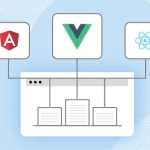Progressive Web Apps (PWAs) are a revolutionary approach to web development that combines the best of both web and native mobile applications. They leverage modern web technologies to provide users with native app-like experiences, offline capabilities, and improved performance, thereby changing the landscape of web development in several ways.
Here are some key ways in which PWAs are changing the web development landscape:
Native App-like Experience

A “native app-like experience” refers to the user interface and interactions provided by a Progressive Web App (PWA) that closely resemble those of a native mobile application. It aims to replicate the feel and functionality of a traditional app that users might download and install from an app store, while still being accessed through a web browser.
Here are some key aspects of a native app-like experience in the context of PWAs:
Home Screen Installation: PWAs can be installed on a user’s home screen, just like native apps. When users visit a PWA-enabled website, they are often prompted to add the app to their home screen. This creates an app icon that users can tap to launch the PWA, making it easily accessible alongside their other apps.
Standalone App Window: When launched from the home screen, PWAs open in a standalone window that resembles a native app interface. The browser’s address bar and navigation elements are typically hidden, providing a distraction-free environment for users.
Smooth Animations and Transitions: PWAs can use animations and transitions to create smooth and engaging user experiences, similar to native apps. These animations can enhance user interactions and make the app feel more polished.
Responsive Design: PWAs are designed to be responsive across various screen sizes and orientations. This ensures that the app looks and functions well on both smartphones and tablets, offering a consistent user experience.
Gestures and Touch Interactions: PWAs can make use of touch gestures and interactions commonly found in native apps, such as swipe gestures, pinch-to-zoom, and tap actions. This adds to the familiarity and usability of the app.
Offline Functionality: While offline capabilities were discussed earlier, they contribute significantly to the native app-like experience. PWAs can provide cached content and essential features even when there’s no internet connection, creating a seamless experience for users, much like native apps that often store data locally.
Smooth Performance: PWAs prioritize performance optimization, ensuring that interactions are responsive and load times are minimized. This contributes to a feeling of fluidity and responsiveness, similar to what users expect from native apps.
Push Notifications: PWAs can send push notifications to users’ devices, even when the app is not actively open. This feature enhances engagement by allowing the app to proactively communicate with users, similar to native apps.
Offline Capabilities

Offline capabilities are a crucial feature of Progressive Web Apps (PWAs) that enable them to function even when a user’s device is not connected to the internet or has limited connectivity. By leveraging service workers and advanced caching techniques, PWAs can offer a seamless experience to users regardless of their network status.
Here’s how offline capabilities work in PWAs:
Service Workers: At the heart of offline capabilities in PWAs are service workers. A service worker is a script that runs in the background, separate from the main browser thread. It acts as a proxy between the web application and the network, allowing developers to control network requests and cache resources.
Caching Strategies: PWAs use various caching strategies to store resources locally on the user’s device. These strategies determine which resources are cached, how they are retrieved, and when they are updated.
- Common caching strategies include:
- Cache-First: This strategy involves serving resources from the cache whenever possible. If a resource is not in the cache, the service worker fetches it from the network and stores a copy in the cache for future use.
- Network-First: In this strategy, the service worker attempts to fetch resources from the network first. If the network is available, it retrieves the latest version of the resource. If the network request fails (due to lack of connectivity), the service worker serves the resource from the cache.
- Stale-While-Revalidate: This strategy combines elements of both cache-first and network-first strategies. The service worker serves the cached resource immediately while simultaneously fetching an updated version from the network. The updated version is then stored in the cache for subsequent use.
Precaching and Dynamic Caching: PWAs can precache essential resources during the initial installation or when the user visits the app for the first time. These resources include HTML files, stylesheets, scripts, images, and more. Additionally, dynamic caching allows resources to be cached on demand as users navigate through the app.
Offline Content: PWAs can provide users with a meaningful offline experience by caching content that is relevant even without an internet connection. For example, an offline news app could cache recent articles, allowing users to read them even when offline.
Background Sync: Some PWAs implement background sync, which enables the app to synchronize data with the server whenever a network connection is available, even if the app is not actively open. This ensures that user data is up-to-date when connectivity is restored.
Improved Performance
Improved performance is a key advantage of Progressive Web Apps (PWAs), and it’s achieved through various techniques and optimizations that enhance the user experience and make web applications feel faster and more responsive.
Here’s how PWAs are designed to deliver improved performance:
Caching and Prefetching: PWAs leverage caching mechanisms to store frequently accessed resources on the user’s device. This includes caching HTML, CSS, JavaScript, images, and other assets. When a user revisits the PWA, these resources can be loaded from the cache, reducing the need to fetch them from the network and resulting in faster load times. Prefetching involves loading resources that the user might need next, proactively improving the perceived speed of the app.
Lazy Loading: Lazy loading is a technique where resources, such as images or scripts, are only loaded when they are needed. This approach speeds up initial page load times by prioritizing the loading of essential content, while non-essential resources are loaded in the background as the user interacts with the app.
Minification and Compression: PWAs often use techniques like minification and compression to reduce the size of CSS, JavaScript, and other code files. Minification removes unnecessary whitespace and renames variables, while compression reduces the file size using algorithms like GZIP or Brotli. Smaller file sizes result in quicker downloads and improved loading times.
Code Splitting: Code splitting involves breaking down a large JavaScript bundle into smaller chunks that can be loaded on demand. This is particularly beneficial for large applications with multiple pages or components. Users only download the code they need, reducing initial load times.
Service Workers: Service workers enable offline capabilities, as discussed earlier, but they also play a role in performance optimization. By intercepting network requests, service workers can decide whether to serve cached content or fetch the latest version from the network. This can result in faster loading of resources, especially when cached content is available.
Background Operations: PWAs can perform certain tasks in the background, separate from the main user interface thread. For example, data synchronization, updates, and cache management can happen without affecting the app’s responsiveness, leading to a smoother user experience.
Cross-Platform Compatibility

Cross-platform compatibility is a fundamental aspect of Progressive Web Apps (PWAs) that allows them to work seamlessly across different devices, operating systems, and browsers. This compatibility is achieved through the use of standardized web technologies and best practices, enabling PWAs to provide a consistent experience regardless of the user’s chosen platform.
Here’s how cross-platform compatibility is realized in PWAs:
Web Standards: PWAs are developed using standard web technologies like HTML, CSS, and JavaScript. These technologies are universally supported by modern web browsers across various platforms, ensuring that the core functionality of the PWA is accessible to users on different devices.
Responsive Design: PWAs are designed with responsiveness in mind. This means that the layout and user interface of the app adapts to different screen sizes, orientations, and resolutions. This responsive design ensures that the app looks and functions well on both desktops and mobile devices.
Media Queries: Media queries are CSS rules that allow developers to apply different styles based on the characteristics of the device, such as screen size, resolution, and orientation. By using media queries, PWAs can deliver tailored experiences to users on different platforms without needing separate codebases.
Viewport Meta Tag: The viewport meta tag in the HTML of a PWA helps control how the content is displayed on various devices. It enables developers to set the initial scale and dimensions of the viewport, ensuring that the app’s layout adapts appropriately to different screen sizes.
Feature Detection: Modern web development emphasizes feature detection over browser detection. This means that instead of checking for specific browsers, developers test for the availability of certain features or APIs. If a feature is supported, the PWA can provide enhanced functionality or optimizations. If not, the PWA still provides a basic, functional experience.
Browser Compatibility: PWAs are built to be compatible with a wide range of modern web browsers, including Chrome, Firefox, Safari, Edge, and more. Browser vendors strive to implement the latest web standards, ensuring that PWAs can deliver a consistent experience across different platforms.





